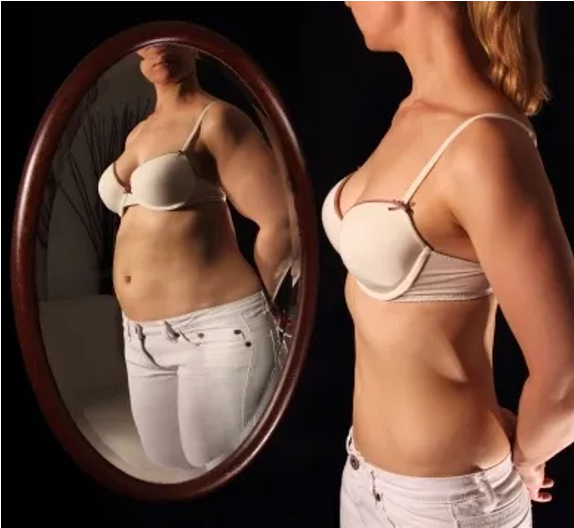|
How do you describe yourself?
It's a question that I would ponder each morning when I pass my bathroom mirror. While at first it may appear as a simple question, it is actually very complicated. The reason for this complication is that there are so many ways we can perceive ourselves, and most are through a limited view of perception. So, if you were to answer this question right now, would it be from a deficit basis, a strengths approach, or from a value-driven perspective? Or would it be based on your character or personality, your processing style, or how you think and feel you are physically? Or would it be how you see yourself fitting into society?

Morning routine
Each morning, I would undress, stand on my tip toes so that I could see my stomach in the medicine cabinet mirror, and then judge myself for how thick I perceived my waistline to be. Next, I would enter the warm shower water and think of how I had an unfit aging body.One morning, things went a bit different for me because when I stood on my tiptoes to judge how bloated my perimenopause stomach appeared to be, I lost my balance, forcing me to take a step forward. I was immediately shocked because I no longer saw the thickness I perceived just a moment ago; instead, I saw a thin, perfectly formed stomach and waistline.At first, I thought that my mind was playing tricks on me until I realized that all my previous mornings, I had been looking in between two panes of mirror on my medicine cabinet - creating a house of mirrors experience. Yet, when I viewed myself through the single mirror I had a different experience, one that made me appreciate my aging body. This new reflection, had me begin to ponder how many of us are experiencing a house of mirrors with our self-perceptions?
Shifting our perceptions

Too often we view ourselves through our perceived deficits rather than our strengths, causing us to decrease our well-being. Yet, the solution to shifting our perception is to increase awareness of all our parts: the good, the not-so-good and the indifferent.Jung shared the importance of shadow work for self-discovery and acceptance. What many do not realize is that these shadow aspects lose their power when we bring them into the light and acknowledge them.
Shadow work: the aspects of self that you would rather keep hidden.
While shadow work is one way that we can bring forth the negative aspects of ourselves to better our self-perceptions, it is through positive psychology that we can discover what makes a good life.
Positive psychology: the science of what makes a good life.
Yet, the area of perception that binds both the shadow and the positive aspects of self, is the area of indifference.Indifference: the aspects of self where we can discover the middle ground of who we are.Shamanism
Within Shamanism, there is a practice called soul retrieval or, as I like to look at it, soul collection. Soul collection is done by collecting your energy or aspects of yourself that you have scattered or lost track of. Soul collection does not have to be a solitary practice as qualified coaches and mental health therapists who work through psychological approaches can help you access these parts of yourself by helping you bring your unconscious into the conscious mind.
Yet, for some the thought to turn to another for help can be overwhelming. Which is why I appreciate the process of soul collection as it can start with you.

Soul Collection
Step one: Write down everything you see yourself as, using the word AND to connect them all together. Think of all the ways that you show up in life: your family role, your work role, your processing style, your strengths, your values and your personality.Here is an example of how I see myself:
I am a justice fighter, AND a highly sensitive person, AND a mother of two amazing boys, AND a wife, AND a sister, AND a friend, AND a middle child, AND a strong woman, AND an artist, educator, and coach, AND a master’s student, AND a Dyslexic, AND one who has a strong sense of spirituality, AND has a love of learning, AND a strong sense of curiosity, AND a strong sense of self-awareness, AND has a drive for fairness, AND creative in all aspects of life, AND holds the values of authenticity, compassion, honesty, peace and wisdom, AND has a strong understanding of patterns that arise in life and situations, AND an introvert, AND a gentle soul, AND a Canadian.
Step two: Notice where you place your energy. How much of it is into your work, family, internal world, possessions, hobbies, or something that uniquely belongs to you?
Step three: Take notice of all the facets that influence how you appear in life.
Here is an example of how I see myself:
I am influenced by my physical health, my mental health, my emotional or feeling health, my family dynamics, my work pressures, my sleep patterns, my biological processing, my usage of my neurotransmitters, my chemical stress levels, my processing levels of noise, smell and sight, my skeletal structure, my muscular structure, and my beliefs of who I am and what I think I need to be.Now that you have a more complete look at who you are, my question is, “If you were to take a step forward to see yourself differently, how would you describe yourself now?”
Step four: With this new awareness, it is essential to offer yourself forgiveness for how you previously saw yourself. When we offer ourselves love, our bodies and lives will respond in kind.Experience wholeness
You are a multifaceted person that does not exist solely through a limited self-perception. To help you facilitate a change I invite you to ponder if you are viewing yourself from a skewed perspective. Next, I hope you lose your balance so that you can take a step forward and see yourself from a different vantage point. Which will hopefully allow you to begin to use even more grace, love, and kindness for how you currently show up. Finally, I encourage you to collect all your parts to experience wholeness rather than fragmentation or a scattered sense of self.

Websites to visit:
https://www.viacharacter.org/character-strengths
https://personalvalu.es/
Sources:
Bashar, D. (n.d.). Woman in white vest and black bikini with hand on chest. [Image]. Unsplash. https://unsplash.com/photos/woman-in-white-vest-and-black-bikini-with-hand-on-chest-xMNel_otvWs
Immerman, E. (2014). We filter things through a fun house mirror. [Image]. Time2Thrive. https://time2thrive.com/we-filter-things-through-a-fun-house-mirror/
Ingerman, S. (2006). Soul retrieval: Mending the fragmented self. Harper One.
Jeffery, S. (July 25, 2024). Shadow work: A definitive guide to Jungian shadow work: How to integrate your dark side. CEOsage. https://scottjeffrey.com/shadow-work/
Nash, J. (December 14, 2015). What is the good life and how to attain it. PositivePsychology.com. https://positivepsychology.com/good-life/.
Pixaby. (n.d). Stacked of stones outdoors. [Image]. Pexels. https://www.pexels.com/photo/stacked-of-stones-outdoors-289586/
|




